| |
 |
 |
 |
|
 |
 |
 |
 |
 |

|
 |
 |
|
|
|
 |
Noted Astrophysicist Michael S. Turner to Head NSF'S Mathematical and Physical Sciences Directorate
|
 |
| |
 The National Science Foundation (NSF) has named celebrated astrophysicist Michael S. Turner of the University of Chicago as Assistant Director for Mathematical and Physical Sciences (MPS). He will head a $1 billion directorate that supports research in mathematics, physics, chemistry, materials and astronomy, as well as multidisciplinary programs and education. Turner is the Bruce V. and Diana M. Rauner Distinguished Service Professor at the University of Chicago where he chairs the department of astronomy and astrophysics. He also has an appointment as a senior scientist at the Fermi National Accelerator Laboratory. The recipient of numerous awards and distinctions during three decades of research, Turner is a member of the National Academy of Sciences and a fellow of the American Physical Society and the American Academy of Arts and Sciences. The National Science Foundation (NSF) has named celebrated astrophysicist Michael S. Turner of the University of Chicago as Assistant Director for Mathematical and Physical Sciences (MPS). He will head a $1 billion directorate that supports research in mathematics, physics, chemistry, materials and astronomy, as well as multidisciplinary programs and education. Turner is the Bruce V. and Diana M. Rauner Distinguished Service Professor at the University of Chicago where he chairs the department of astronomy and astrophysics. He also has an appointment as a senior scientist at the Fermi National Accelerator Laboratory. The recipient of numerous awards and distinctions during three decades of research, Turner is a member of the National Academy of Sciences and a fellow of the American Physical Society and the American Academy of Arts and Sciences.
Image courtesy: University of Chicago
Read the full story. ... Posted
6/27/03
|
 |
New Catalyst Paves Way for Cheap, Renewable Hydrogen
|
 |
| |
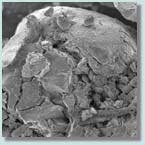 Scientists have developed a hydrogen-making catalyst that uses cheaper materials and yields fewer contaminants than do current processes, while extracting the element from common renewable plant sources. Further, the new catalyst lies at the heart of a chemical process the authors say is a significant advance in producing alternate fuels from domestic sources. In the June 27 issue of the journal Science, James Dumesic, John Shabaker and George Huber, of the University of Wisconsin at Madison, report developing the catalyst from nickel, tin and aluminum and using it in a process called aqueous-phase reforming (APR), which converts plant byproducts to hydrogen. The process performs as well as current methods that use precious metals such as platinum, yet runs at lower temperatures and is much cleaner. Scientists have developed a hydrogen-making catalyst that uses cheaper materials and yields fewer contaminants than do current processes, while extracting the element from common renewable plant sources. Further, the new catalyst lies at the heart of a chemical process the authors say is a significant advance in producing alternate fuels from domestic sources. In the June 27 issue of the journal Science, James Dumesic, John Shabaker and George Huber, of the University of Wisconsin at Madison, report developing the catalyst from nickel, tin and aluminum and using it in a process called aqueous-phase reforming (APR), which converts plant byproducts to hydrogen. The process performs as well as current methods that use precious metals such as platinum, yet runs at lower temperatures and is much cleaner.
Image courtesy: G. W. Huber, J. W. Shabaker, and J. A. Dumesic, University of Wisconsin-Madison; NSF, DOE
Read the full story. ... Posted
6/26/03
|
 |
For Ferrets, GPI Means 'Get Pregnancy Initiated'
|
 |
| |
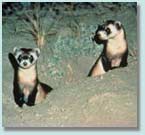 Knowing what makes a ferret pregnancy take hold
could help biologists save endangered species or understand how tumors spread. Specifically, biologists examining early pregnancy in domestic ferrets report they have identified a protein necessary for
embryos to implant successfully in the wall of the uterus, which is pregnancy's first step in mammals.
Newly discovered as a molecular signal in ferret pregnancies, the protein -- glucose-6-phosphate isomerase (GPI) -- has long been known for its wide-ranging role in metabolism, where it breaks down sugars in organisms as diverse as bacteria and humans. Researchers Laura Clamon Schulz and Janice M. Bahr at the
University of Illinois at Urbana-Champaign report their results
in the Proceedings of the National Academy of Sciences. According to Bahr, "The identification of GPI as a key signal
secreted from mother to embryo in the ferret is an important step
forward in the understanding of pregnancy in this and related
species." Knowing what makes a ferret pregnancy take hold
could help biologists save endangered species or understand how tumors spread. Specifically, biologists examining early pregnancy in domestic ferrets report they have identified a protein necessary for
embryos to implant successfully in the wall of the uterus, which is pregnancy's first step in mammals.
Newly discovered as a molecular signal in ferret pregnancies, the protein -- glucose-6-phosphate isomerase (GPI) -- has long been known for its wide-ranging role in metabolism, where it breaks down sugars in organisms as diverse as bacteria and humans. Researchers Laura Clamon Schulz and Janice M. Bahr at the
University of Illinois at Urbana-Champaign report their results
in the Proceedings of the National Academy of Sciences. According to Bahr, "The identification of GPI as a key signal
secreted from mother to embryo in the ferret is an important step
forward in the understanding of pregnancy in this and related
species."
Photo courtesy: U.S. Fish and Wildlife Service
Read the full story. ... Posted
6/25/03
|
 |
Scientists Announce First 3-D Assembly of Magnetic and Semiconducting Nanoparticles
|
 |
| |
 Scientists from Columbia University, IBM and the University of New Orleans today announced a new, three-dimensional designer material assembled from two different types of particles only billionths of a meter across. In the June 26 issue of the journal Nature, the team describes the precision chemistry methods developed to tune the particles' sizes in increments of less than one nanometer and to tailor the experimental conditions so the particles would assemble themselves into repeating 3-D patterns. Designing new materials with otherwise unattainable properties, sometimes referred to as "metamaterials," is one of the promises of nanotechnology. Two-dimensional patterns had previously been created from gold nanoparticles of different sizes and mixtures of gold and silver. Extending this concept to three dimensions with more diverse types of materials demonstrates the ability to bring more materials together than previously realized. Scientists from Columbia University, IBM and the University of New Orleans today announced a new, three-dimensional designer material assembled from two different types of particles only billionths of a meter across. In the June 26 issue of the journal Nature, the team describes the precision chemistry methods developed to tune the particles' sizes in increments of less than one nanometer and to tailor the experimental conditions so the particles would assemble themselves into repeating 3-D patterns. Designing new materials with otherwise unattainable properties, sometimes referred to as "metamaterials," is one of the promises of nanotechnology. Two-dimensional patterns had previously been created from gold nanoparticles of different sizes and mixtures of gold and silver. Extending this concept to three dimensions with more diverse types of materials demonstrates the ability to bring more materials together than previously realized.
Photo courtesy: IBM
Read the full story. ... Posted
6/25/03
|
 |
Behavior of Arctic Ocean Ridge Confounds Predictions; May Lead to New Insights into Crust Formation
|
 |
| |
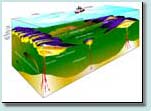 The discovery that an ocean ridge under the Arctic ice cap is unexpectedly volcanically active and contains multiple hydrothermal vents may cause scientists to modify a decades-long understanding of how ocean ridges work to produce the Earth's crust. The new results, which come from a study of the Gakkel Ridge, one of the slowest spreading ridges on Earth, have broad implications for the understanding of the globe-encircling mid-ocean ridge system where melting of the underlying mantle creates the ocean floor. In two articles appearing in the June 26 edition of the journal Nature, scientists supported by the National Science Foundation and Deutsche Forschungsgemeinschaft present striking new results obtained during a nine-week research cruise that lasted from August to October of 2001. The discovery that an ocean ridge under the Arctic ice cap is unexpectedly volcanically active and contains multiple hydrothermal vents may cause scientists to modify a decades-long understanding of how ocean ridges work to produce the Earth's crust. The new results, which come from a study of the Gakkel Ridge, one of the slowest spreading ridges on Earth, have broad implications for the understanding of the globe-encircling mid-ocean ridge system where melting of the underlying mantle creates the ocean floor. In two articles appearing in the June 26 edition of the journal Nature, scientists supported by the National Science Foundation and Deutsche Forschungsgemeinschaft present striking new results obtained during a nine-week research cruise that lasted from August to October of 2001.
Image courtesy: Paul Oberlander / Woods Hole Oceanographic Institution
Read the full story. ... Posted
6/25/03
|
 |
Scientists Are Monitoring Potentially Toxic Blue-Green Algae in Wisconsin Lakes
|
 |
| |
 Scientists at NSF's North Temperate Lakes Long-Term Ecological Research (LTER) site are gearing up this summer to monitor an exotic blue-green algae that has been migrating northward in the United States. In recent years, the organism has been detected as far north as lakes in Madison, Wisc. While commonly called a blue-green algae, it is actually a cyanobacterium known as Cylindrospermopsis raciborskii, or "Cylindro." Originally identified in Brazil, Cylindro has been found in several southern states as well as in Illinois, Indiana, Michigan, Minnesota and Ohio. Starting in late July and extending through September, scientists at the NSF LTER site and affiliated with the University of Wisconsin at Madison, along with researchers at the Wisconsin Department of Natural Resources, will collect water samples from Madison-area lakes. Scientists at NSF's North Temperate Lakes Long-Term Ecological Research (LTER) site are gearing up this summer to monitor an exotic blue-green algae that has been migrating northward in the United States. In recent years, the organism has been detected as far north as lakes in Madison, Wisc. While commonly called a blue-green algae, it is actually a cyanobacterium known as Cylindrospermopsis raciborskii, or "Cylindro." Originally identified in Brazil, Cylindro has been found in several southern states as well as in Illinois, Indiana, Michigan, Minnesota and Ohio. Starting in late July and extending through September, scientists at the NSF LTER site and affiliated with the University of Wisconsin at Madison, along with researchers at the Wisconsin Department of Natural Resources, will collect water samples from Madison-area lakes.
Photo courtesy: John J. Magnuson/LTER Network
Read the full story. ... Posted
6/23/03
|
 |
Grid Community Pulls Together to Battle SARS in Taiwan
|
 |
| |
 Grid computing researchers around the Pacific Rim have mobilized to fight the SARS epidemic, helping establish a cutting-edge communication grid among quarantined hospitals across Taiwan. In addition to linking the hospitals to each other, the grid connects doctors to global sources of health information. On May 15, in search of expertise for setting up Access Grid sites, Taiwan's National Center for High-performance Computing sent a request to members of the Pacific Rim Applications and Grid Middleware Assembly (PRAGMA). Led by the San Diego Supercomputer Center at the University of California, San Diego, offers of assistance poured in from all PRAGMA sites within hours, including Argonne National Laboratory where the Access Grid was developed. Grid computing researchers around the Pacific Rim have mobilized to fight the SARS epidemic, helping establish a cutting-edge communication grid among quarantined hospitals across Taiwan. In addition to linking the hospitals to each other, the grid connects doctors to global sources of health information. On May 15, in search of expertise for setting up Access Grid sites, Taiwan's National Center for High-performance Computing sent a request to members of the Pacific Rim Applications and Grid Middleware Assembly (PRAGMA). Led by the San Diego Supercomputer Center at the University of California, San Diego, offers of assistance poured in from all PRAGMA sites within hours, including Argonne National Laboratory where the Access Grid was developed.
Photo courtesy: National Center for High-performance Computing, Taiwan
Read the full story. ... Posted
6/17/03
|
 |
House Speaker Hastert, Science Committee Chairman Boehlert and Members of a Recent Congressional Delegation to Antarctica Present NSF Director Colwell with Flag
|
 |
| |
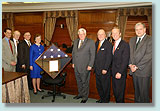 On June 12, House Speaker J. Dennis Hastert (R-IL), Science Committee Chairman Sherwood Boehlert (R-NY), and members of a recent Congressional delegation to Antarctica presented NSF Director Rita Colwell with the American flag that flew over the U.S. Capitol building from March 3-7, 2003, as NSF's new South Pole Research Station was being occupied for the first time. The station is one of the world's best astronomy observatories and is also one of the best places on Earth for studying seismic waves as they travel through the Earth as the result of earthquakes. Pictured from left to right are: Rep. Anthony Weiner (D-NY), Rep. Roscoe Bartlett (R-MD), Rep. Nick Smith (R-MI), NSF Director Colwell, Speaker Hastert, Chairman Boehlert, Rep. Todd Akin (R-MO) and Scott Palmer, Speaker Hastert's Chief of Staff. The ceremony took place in the House Science Committee hearing room in the Rayburn House Office Building. On June 12, House Speaker J. Dennis Hastert (R-IL), Science Committee Chairman Sherwood Boehlert (R-NY), and members of a recent Congressional delegation to Antarctica presented NSF Director Rita Colwell with the American flag that flew over the U.S. Capitol building from March 3-7, 2003, as NSF's new South Pole Research Station was being occupied for the first time. The station is one of the world's best astronomy observatories and is also one of the best places on Earth for studying seismic waves as they travel through the Earth as the result of earthquakes. Pictured from left to right are: Rep. Anthony Weiner (D-NY), Rep. Roscoe Bartlett (R-MD), Rep. Nick Smith (R-MI), NSF Director Colwell, Speaker Hastert, Chairman Boehlert, Rep. Todd Akin (R-MO) and Scott Palmer, Speaker Hastert's Chief of Staff. The ceremony took place in the House Science Committee hearing room in the Rayburn House Office Building.
Photo courtesy: Heidi Tringe
View a larger version of the image. . ... Posted
6/12/03
|
 |
Earliest Homo Sapiens
Fossils Discovered in Ethiopia
|
 |
| |
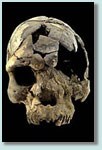 Scientists from the University of California at Berkeley along with researchers from Ethiopia and several other countries have uncovered fossils of the earliest modern human, Homo sapiens, estimated at 154,000 to 160,000 years old. According to the scientists, the findings provide strong evidence that Homo sapiens and Neanderthals co-existed, rather than the former descending from the latter. In two articles appearing in the June 12 edition of the journal Nature, the authors describe the fossilized crania of two adults and a child uncovered at the Herto village in the Middle Awash study area of Ethiopia, about 140 miles northeast of its capital, Addis Ababa. The fossils fill a major gap in the human fossil record, the scientists report. Scientists from the University of California at Berkeley along with researchers from Ethiopia and several other countries have uncovered fossils of the earliest modern human, Homo sapiens, estimated at 154,000 to 160,000 years old. According to the scientists, the findings provide strong evidence that Homo sapiens and Neanderthals co-existed, rather than the former descending from the latter. In two articles appearing in the June 12 edition of the journal Nature, the authors describe the fossilized crania of two adults and a child uncovered at the Herto village in the Middle Awash study area of Ethiopia, about 140 miles northeast of its capital, Addis Ababa. The fossils fill a major gap in the human fossil record, the scientists report.
Image credit: Photo © 2000 David L. Brill \ Brill Atlanta
Read the full story. ... Posted
6/11/03
|
 |
Antarctic Research Vessel Heads North to Map Arctic Waters
|
 |
| |
 An ice-breaking Antarctic research vessel will sail to the Arctic for the first time this summer to conduct a comprehensive survey of the chemistry, temperature and other characteristics of the waters off Alaska. The research vessel Nathaniel B. Palmer usually operates in the Southern Hemisphere for the U.S. Antarctic Program, which is managed by the National Science Foundation. But this summer, a team of NSF-funded Arctic researchers will use the Palmer as a platform to map the distribution of salinity, temperature, nutrients and other characteristics over the outer shelf to deep basin region of the Chukchi and Beaufort seas off northern Alaska. An ice-breaking Antarctic research vessel will sail to the Arctic for the first time this summer to conduct a comprehensive survey of the chemistry, temperature and other characteristics of the waters off Alaska. The research vessel Nathaniel B. Palmer usually operates in the Southern Hemisphere for the U.S. Antarctic Program, which is managed by the National Science Foundation. But this summer, a team of NSF-funded Arctic researchers will use the Palmer as a platform to map the distribution of salinity, temperature, nutrients and other characteristics over the outer shelf to deep basin region of the Chukchi and Beaufort seas off northern Alaska.
Image credit: Kristin Cobb/NSF
Read the full story. ... Posted
6/9/03
|
 |
Workshop: Will Today's Innovations in Graduate Education Meet the Challenges of the Future?
|
 |
| |
 Advanced education faces significant challenges from the impact of changing population demographics, the information technology revolution, the globalization of science, and evolving workforce needs, but lacks key data needed to evaluate educational innovations, according to participants of the NSF-hosted "Future of Graduate Education Workshop." NSF's Directorate of Education and Human Resources published the workshop's summary online today at www.ehr.nsf.gov/dge/InnovMTG.htm. The workshop, held March 19-20, sought to identify the potential impact of forces changing the future environment of graduate education, to define the desirable characteristics of graduate education, and to identify what is necessary to ensure graduate-level education meets the emerging needs of the nation. Advanced education faces significant challenges from the impact of changing population demographics, the information technology revolution, the globalization of science, and evolving workforce needs, but lacks key data needed to evaluate educational innovations, according to participants of the NSF-hosted "Future of Graduate Education Workshop." NSF's Directorate of Education and Human Resources published the workshop's summary online today at www.ehr.nsf.gov/dge/InnovMTG.htm. The workshop, held March 19-20, sought to identify the potential impact of forces changing the future environment of graduate education, to define the desirable characteristics of graduate education, and to identify what is necessary to ensure graduate-level education meets the emerging needs of the nation.
Image credit: University Photocommunications, Southern Illinois University Carbondale
Read the full story. ... Posted
6/9/03
|
 |
Going with the Grain: A Tale of Rice's Smallest Chromosome
|
 |
| |
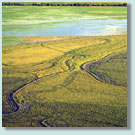 Behold a grain of rice. Inside are thousands of cells; within each cell are 12 chromosomes; and on riceís smallest chromosome, No. 10, are about 3,500 genes and more than 22 million base pairs, the links in the chain of DNA. So, whatís the big deal about riceís smallest chromosome? There are several, according to a report in the June 6 issue of the journal Science. Upon close examination, chromosome 10 has about twice as many genes as were predicted when an international consortium announced a draft genome sequence in the same journal last December. An organismís genome consists of the entire genetic code held in its DNA. Of potentially greater significance, a detailed look at chromosome 10 shows that the genome map of rice is similar to other grains, particularly sorghum and maize. Behold a grain of rice. Inside are thousands of cells; within each cell are 12 chromosomes; and on riceís smallest chromosome, No. 10, are about 3,500 genes and more than 22 million base pairs, the links in the chain of DNA. So, whatís the big deal about riceís smallest chromosome? There are several, according to a report in the June 6 issue of the journal Science. Upon close examination, chromosome 10 has about twice as many genes as were predicted when an international consortium announced a draft genome sequence in the same journal last December. An organismís genome consists of the entire genetic code held in its DNA. Of potentially greater significance, a detailed look at chromosome 10 shows that the genome map of rice is similar to other grains, particularly sorghum and maize.
Image credit: USDA Photo
Read the full story. ... Posted
6/5/03
|
 |
Ancient Pollen Yields Insight into Forest Biodiversity
|
 |
| |
 By analyzing data on tree pollen extracted from ancient lake sediments, ecologists have sharpened the understanding of how forests can maintain a diversity of species. Their findings indicate that stabilizing processes have been more important than previously thought, and that the human-caused loss of species could upset that stability in ways that remain poorly understood. "Quantifying the link between stability and diversity, and identifying the factors that promote species diversity, have challenged ecologists for decades," said Saran Twombly, program director in NSF's division of environmental biology, which funded the research. "The contribution of this study is unique, as the scientists used a clever blend of long-term data and statistical modeling to test the opposing hypotheses of neutrality and stability as key factors promoting community assembly and diversity." By analyzing data on tree pollen extracted from ancient lake sediments, ecologists have sharpened the understanding of how forests can maintain a diversity of species. Their findings indicate that stabilizing processes have been more important than previously thought, and that the human-caused loss of species could upset that stability in ways that remain poorly understood. "Quantifying the link between stability and diversity, and identifying the factors that promote species diversity, have challenged ecologists for decades," said Saran Twombly, program director in NSF's division of environmental biology, which funded the research. "The contribution of this study is unique, as the scientists used a clever blend of long-term data and statistical modeling to test the opposing hypotheses of neutrality and stability as key factors promoting community assembly and diversity."
Image credit: USDA Photo
Read the full story. ... Posted
6/5/03
|
 Top
of Page Top
of Page
|
|
|
 |
 |
 |
 |
 |
 |
 |
 |
|
 |
 |
 |
|
|

